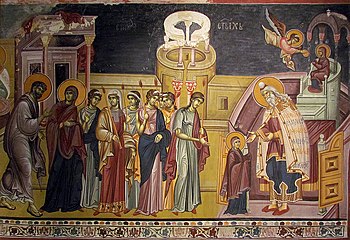Michael Astrapas and Eutychios

Michael Astrapas and Eutychios (Greek: Μιχαήλ Αστραπάς και Ευτύχιος (flourished 1294 to 1317) were Greek painters from Thessaloniki. They had a very active workshop in the area and some of their work survived. Famous Thessalonian painter Manuel Panselinos was active around the same period. Thessaloniki was considered the second capital of the Byzantine Empire. The region featured many iconographic workshops. Most historians consider Thessaloniki the epicenter of the Macedonian School of painting during the Palaeologan Renaissance. Other prominent Byzantine artists were Ioannis Pagomenos, Theophanes the Greek and Theodore Apsevdis. The Byzantine style influenced countless Italian and Greek artists. The style eventually evolved into the Maniera Greca.[1]
History
Michael Astrapas and Eutychios were active painters in Northern Greece and the Macedonian region. Not much is known about the artists. Luckily they signed their work. There are documented stories about the work that did not survive. There were many active iconographic workshops in Thessaloniki. It was the second capital of the Byzantine Empire. Manuel Panselinos had a famous workshop in the same geographic region. The artists followed the traditional Byzantine style. Michael Astrapas and Eutychios traveled all over the empire from modern Greece, North Macedonia, and Serbia.[2]
The artists were invited to Serbia by king Stefan Milutin. They were also hired by other patrons to work in their dominions on commissions as icon painters. The names Michael and Eutychios were persevered in the inscriptions of four churches at Staro Nagoricino, Prizren, Banjani, and Ohrid. The frescoes exhibit strong chiaroscuro and heavy folds within the heavy drapery. There is a frescos cycle outlining the life of Mary including the Dormition. This can be found in the prothesis of the Church of Saint George.[3][4]
One theory explains that Eutychios Astrapas was Michael Astrapas's father. Markovic explains that because of the difference in painting styles a plausible argument can be made that there is a father-son relationship between the two artists. Some of the work was signed the hand of Michael, son of Eutychios.[5]
Gallery
-
Fresco of Constantine Cavassila
-
Matthew the Apostle
-
St.George Ascension of Our Lady
-
Presentation of the Mother of God in the Temple 1313–14.
-
Resurrection
-
Baptism of Jesus
-
Doubting of Thomas
Notable works
- Church of the Holy Mother of God Peribleptos at Ohrid (1294)
- Church of Saint Niketas at Čucer Sandevo (before 1315)
- Church of Our Lady of Ljeviš in Prizren (1307)
- Church of Saint George at Staro Nagoričane (1317)
See also
References
- ^ Kyriakou, Stilpanos P (1960). The Painter Michael Astrapas (PDF). Thessaloniki, Greece: The Society of Macedonian Studies. pp. 545–547.
- ^ Kyriakou, 1960, pp. 545-547
- ^ Pentiuc, Eugen J. (2014). The Old Testament in Eastern Orthodox Tradition. New York: Oxford University Press. p. 316.
- ^ Nenad Vesic (2021). "Materials and conservational interventions on the byzantine monasteries of the Balkan painted by Michael and Eutychios Astrapas". National Technical University of Athens School of Chemical Engineering. Retrieved June 19, 2021.
- ^ Markovic, Miodrag (2021). The Painter Eutychios — Father of Michael Astrapas and Protomaster of the Frescoes in the Church of the Virgin Peribleptos in Ohrid. Belgrade Serbia: University of Belgrade. pp. 30–31.
Further reading
- SALVADOR-GONZALEZ, J. M. (2011). The Death of the Virgin Mary (1295) in the Macedonian church of the Panagia Peribleptos in Ohrid. Iconographic interpretation from the perspective of three apocryphal writings. Mirabilia. Electronic Journal of Antiquity & Middle Ages, Nº 13, Julio-Diciembre 2011, Institut d’Estudis Medievals, Universitat Autònoma De Barcelona, p. 237–268. ISSN 1676-5818. doi:10.13140/2.1.4371.8086.
External links
- Greek painters
- Byzantine painters
- Byzantine Thessalonians
- 13th-century births
- 14th-century deaths
- Christianity in medieval Macedonia
- Art duos
- People of the Kingdom of Serbia (medieval)
- 13th-century Byzantine people
- 14th-century Byzantine people
- 13th-century Greek people
- 14th-century Greek people
- 13th-century Greek painters
- 14th-century Greek painters
- Byzantine people stubs







